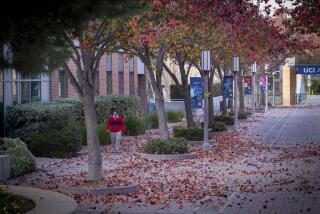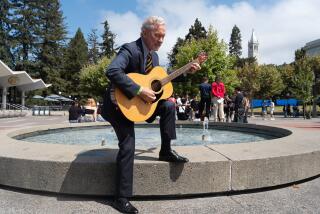Teaching-to-Administration Transfers Out : State Tightens Cal State Budget Process
LONG BEACH — A chancellor’s edict touching on a sensitive issue that has caught the attention of both a faculty union and the state Legislature could change the way administrators at California State University, Long Beach, do their jobs for some time to come.
Issued last week following a $900,000 shortfall and subsequent suspension of university President Stephen Horn’s budgetary authority, the order prevents the transfer of funds between state-mandated budget categories on the campus. Thus, administrators will no longer be able to borrow from one category--such as instruction--to meet deficits in another, such as operations or administration.
“What it’s going to mean . . . is more advanced planning,” Horn said.
Added Robyn Mack, director of the budget: “In the past we did our spending first and then our documentation. Now we must do our documentation first, and then our spending.”
Chief Fiscal Officer Urged
Other orders in the two-page report include creating a chief fiscal officer directly under Horn to supervise and make major decisions regarding the budget, a surplus fund to cover unanticipated expenses and more detailed financial reviews in individual departments.
But the issue of funding transfers between budgetary categories is one that goes to the heart of the way the university is run and has been the subject of allegations for months.
Last April, members of the faculty union charged that administrators at CSULB and other state university campuses had funneled millions of dollars intended for instructional purposes into budget categories used to pay for spiraling administrative costs. Those allegations led to a legislative provision that will revise procedures throughout the system to make actual expenditures conform more closely to budgeted ones.
Also, funding transfers are among the objects of a special audit at the Long Beach campus now being conducted by the state auditor general’s office and expected to be completed this fall.
“It has been a very controversial issue,” said Pamela Spratlen, a senior consultant on higher education for the state Assembly Ways and Means Committee, which heard the union’s complaints. “This whole thing blowing up in Long Beach has simply added fuel to it.”
No Laws Said Broken
CSULB administrators confirm that they have used money, earmarked by the Legislature as instructional, for administrative purposes. But in so doing, they say, they have simply used it where it was most needed rather than abiding by outmoded and unrealistic state formulas. And in transferring the money, they say, they have broken no laws and have not violated any customs.
At issue is the way money is funneled from the government to the California State University system’s 19 campuses. Traditionally, educators say, funds have been allocated according to a formula developed by the state in four broad categories: instruction, which includes faculty salaries and instructional materials; academic support, which covers such things as the library and computer services; student services, including health centers and counseling; and institutional support, which covers most administrative costs.
While the state has long mandated how much money would go into each category, local administrators were given a great deal of discretion in transferring funds among them. Earlier this year, members of the California Faculty Assn.--the union representing the system’s 19,500 teachers--documented that administrators throughout the system had indeed made wide use of that discretion.
“We couldn’t believe it,” said Paul Worthman, the union’s associate general manager. “We discovered that the (power of the) campus presidents was enormous.”
$15.5 Million Transferred
In fiscal 1984-85, he said, the system’s campuses transferred about $15.5 million out of instructional and related programs, mostly into institutional support. At Long Beach, which had one of the highest transfer rates, he said, $1.8 million, or about 2.7% of the $67-million instructional budget, was transferred out.
“The instructional faculty budget is the cash cow that administrators milk to feed their excesses elsewhere in the system,” Worthman said. “What it means is that students suffer.”
Particularly irksome in light of this trend, he said, were the dramatic salary increases of certain CSULB administrators over the past three years, amounting up to 68%.
But administrators put a somewhat different face on the same set of statistics.
Louis Messner, assistant vice chancellor of budget planning for the CSU system, said that statewide the transfers amounted to only a minuscule portion of the budget and were largely “of a technical nature to accommodate (variations) in the staff benefits of one program versus another.”
And at the Long Beach campus, according to Mack, they were necessary because the state budgeting formulas “do not provide adequate support” for activities such as staff development, faculty recruitment, admissions and records, accounting, health, occupational safety and instructional computing.
‘We’ve Complained’
“As the year progresses and the administration begins to see needs, we transfer funds to meet them,” she said. “We’ve complained for many years; the (budgeting) formulas were developed 15 years ago and have not been adjusted on a routine basis, yet the Department of Finance still holds to them.”
None of the transferred money, she said, went to the administrative salary increases, which were provided for by a separate portion of the budget and coincided with changes in the university’s methods of evaluating employees that allowed more flexibility in determining their merit.
Nonetheless, legislators in Sacramento--to whom the union appealed in mid-April as the new state budget was being hammered out--were sufficiently impressed to include an item in the supplemental report accompanying this year’s spending bill. It requires the university system to “revise its budgeting procedures . . . so that actual expenditures conform more closely to budgeted expenditures within each of the major program and sub-program classifications.”
And in issuing its report on the CSULB shortfall, the chancellor’s office found it pertinent to include an item instructing Horn to “direct that budget allocations to the divisions will be maintained in program format, in agreement with legislatively authorized budget categories.”
On the state level, CSU officials and legislative experts say, the new truth-in-budgeting methods will require the close cooperation of the university and the government and may ultimately lead to revisions in the state budgeting formulas used to allocate education funds.
‘Spend Money in Place’
At CSULB, according to Mack, it will mean three things:
First, she said, whenever possible university administrators will from now on “spend money in place” rather than move it around. In other words, if an administrator in an academic department needs money for a non-academic purpose, it will come out of that administrator’s instructional budget rather than from the institutional support budget.
Second, she said, administrators on all levels will be asked to do much more detailed financial planning earlier in the fiscal year. This will require far more paper work than is now done, she said, but will be well worth the effort.
And finally, Mack said, there will be a renewed emphasis on instructional needs versus the physical or support needs of the institution. Already, she said, teams of administrators are poring over the budget to determine what kinds of institutional support items can be eliminated or postponed. Potential targets, she said, include such things as tree trimming, window washing, administrative travel and memberships in professional organizations.
By December, Mack said, there should be a major assessment of what is fluff and what isn’t.
“We will not cut support for instruction,” she said. “But if the floors have to go unwaxed for a time . . . we’re going to do it.”
More to Read
Sign up for Essential California
The most important California stories and recommendations in your inbox every morning.
You may occasionally receive promotional content from the Los Angeles Times.










